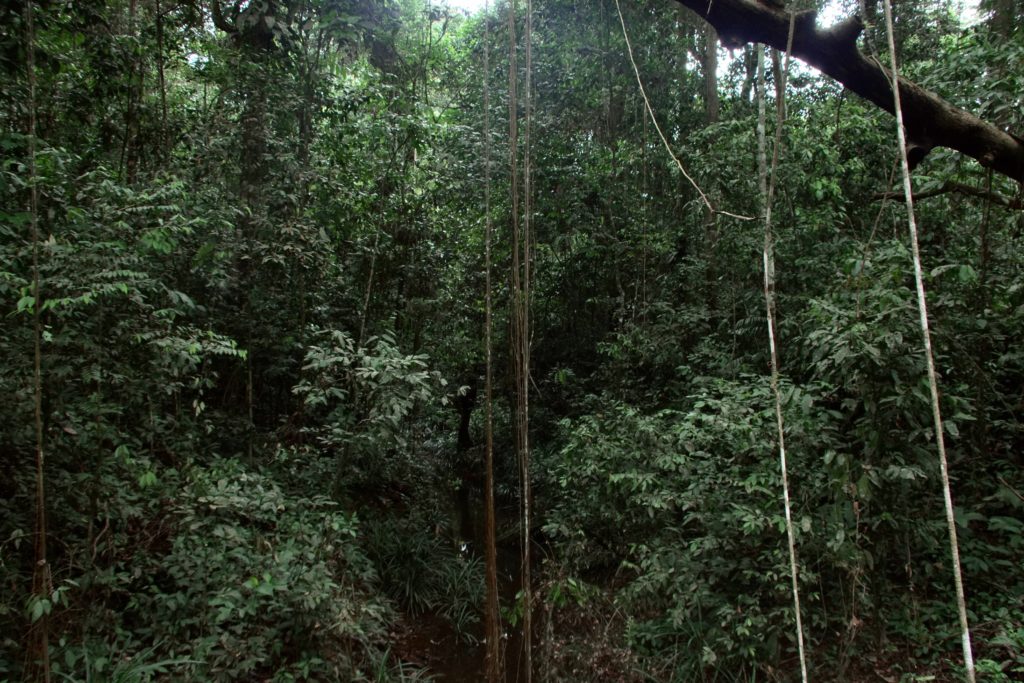RAINFOREST
Environment
The Borneo rainforest is 130 million years old, making it one of the oldest rainforests in the world and 70 million years older than the Amazon rainforest.
Borneo is very rich in biodiversity compared to many other areas.
There are about 15,000 species of flowering plants with 3,000 species of trees, 221 species of mammals and 420 species of birds.
Subject to mass deforestation, the remaining Borneo rainforest is one of the only remaining natural habitat for the endangered Bornean Orangutan.
It is also an important refuge for many endemic forest species, as the Asian Elephant, the Sumatran Rhinoceros, the Bornean Clouded Leopard, and the Dayak Fruit Bat.
Rainforest in the KUTAI National Park. East Kalimantan. Borneo

East Kalimantan is an Indonesian province on the island of Kalimantan spanning an area of just under 50,000 square miles, over half of which is covered by 18 million acres of tropical forest. It is one of Indonesia’s wealthiest provinces, both ecologically and economically, but the region is grappling with a 30-year legacy of forest depletion and degradation caused by logging, palm oil production and mining, further exacerbated by raging forest fires. The loss of East Kalimantan’s forest is a threat to its economic stability, the peace and prosperity of its population, and its extraordinary biodiversity – which includes 5% of the world’s remaining wild orangutan.
COAL
There ís a lot of traffic on the Mahakam which is still, despite construction of lots of roads, a major highway into ‘The Interior’. And a lot of that traffic consists of coal barges.
Huge floating steel trays, each one hauled behind a large tugboat. Full barges, low in the water, heading downstream, and empty ones returning back upstream to be refilled.
The mining companies truck the coal to the river, where it gets crushed, stockpiled, and then loaded onto the barges.
These barges are big. Upriver (upstream of the Mahakam Lakes) they can ‘only’ manage a load of 5000 tonnes, but the downstream barges may carry 7-8,000 tonnes of coal.
The content of each barge gets loaded onto ocean-going freighters – near the river mouth, at offshore transfer stations, or at the port down here in Balikpapan. Some even gets towed across the Java Sea to Surabaya for local (Indonesian) use, but most is exported – primarily to China, India, Japan and Korea.
Kutai National Park
East Kalimantan. Indonesian Borneo/
2022
4K
Reel Duration: 9’38
Kutai National Park
East Kalimantan. Indonesian Borneo/
2022
4K
Reel Duration: 9’38
Palm OIl
Indonesia is the world’s largest producer of palm oil. In 2016, Indonesia produced 34.5 million tonnes of palm oil and exported 25.1 million tonnes. The total planted area of oil palm is estimated to be around 12 million hectares and is projected to reach 13 million hectares by 2020.
The Indonesian palm oil industry is dominated by large-scale private enterprises and smallholders, with government-schemes only playing a modest role. Private enterprises produce roughly half of the palm oil and smallholders produce around 40%.
Major ecological threats from palm oil plantations are deforestation, biodiversity loss, and carbon emissions resulting from land use change and forest fires. The disregard of indigenous rights by the palm oil production sector is also an area of high concern.
Kutai National Park
East Kalimantan. Indonesian Borneo/
2022
4K
Reel Duration: 9’38
DEFORESTATION
Deforestation in Borneo has taken place on an industrial scale since the 1960s.
In the 1980s and 1990s, the forests of Borneo were leveled at a rate unprecedented in human history, burned, logged and cleared, and commonly replaced with agriculture. The deforestation continued through the 2000s at a slower pace, alongside the expansion of palm oil plantations. Half of the annual global tropical timber procurement is from Borneo. Palm oil plantations are rapidly encroaching on the last remnants of primary rainforest. Much of the forest clearance is illegal.
As well as Borneo’s importance in biodiversity conservation and as a carbon sink, the forests have significance for water security and food sovereignty for local communities of indigenous peoples
Kutai National Park
East Kalimantan. Indonesian Borneo/
2022
4K
Reel Duration: 9’38
ENERGY IN INDONESIA
Despite the country’s efforts to convert to more sustainable sources of energy, petroleum remains the backbone of energy provision in Indonesia, a country populated by 240 million people. Not only is the burning of fossil fuels a source of CO2 emissions, its exploration and exploitation are capital-intensive, a challenge for the country, and exposes communities and ecosystems to the risk of accidents like the Balikpapan oil spill in March 2018 to occur.
Pertamina produces about 800,000 to 1 million barrels of crude oil daily, leaving a 200-400,000 barrels gap to be imported. The spill in Balikpapan, the cost of which has been estimated in a decrease in oil supply of 200,000 barrels a day, is causing the gap to widen even further.
The worst cases of oil spills happened even with leading oil companies in the world, suggesting that even best industry practices aren’t a guarantee that incidents won’t occur.
Kutai National Park
East Kalimantan. Indonesian Borneo/
2022
4K
Reel Duration: 9’38
NUSANTARA
Kutai National Park
East Kalimantan. Indonesian Borneo/
2022
4K
Reel Duration: 9’38